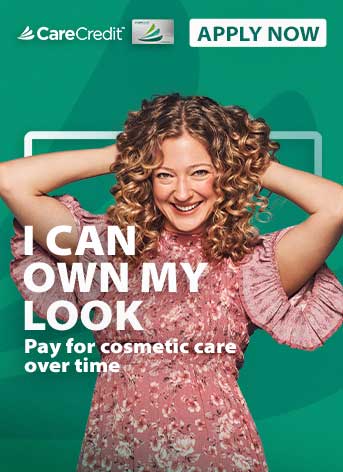During an interview with CareCredit, board-certified plastic surgeon Dr. Daniel Barrett discusses breast augmentation and how it can transform the lives of his patients. Here are some of the questions he answers.*
What Is Breast Augmentation?
Breast augmentation (also known as a boob job) is a cosmetic procedure designed to make breasts bigger. The procedure is commonly done with implants (saline or silicone) or fat transfer.
Who Is a Good Candidate for Breast Augmentation?
You may be a good candidate for breast augmentation if you:
- Have thought about getting larger breasts for some time
- Are thinking about the procedure in terms of your own goals
- Don't have any medical problems
- Understand that this is a surgical procedure
What Should You Look For in a Plastic Surgeon?
Here are a few key things:
- Board certification: Are they Board-certified by the American Board of Plastic Surgery? This is a basis of credibility.
- Experience: Do they do a lot of breast augmentations (4-5 per month minimum)? Look at their websites, read reviews, and check out boob job before and after pictures. More experienced surgeons often have lower complications and better outcomes.
- In-person consultation: Meet with your surgeon to make sure you're on the same page. You want to make sure that you can trust your doctor by ensuring it's a good fit interpersonally. You also want to make sure your goals are aligned, and the best way to ensure that is by talking to your surgeon.
What Questions Should You Ask?
Good questions to ask your doctor include:
- Are you board-certified?
- How many breast augmentations do you do a week?
- What is something that you do that other doctors don't do?
- What is your capsular contracture rate?
- What do you do for scarring?
- Do you do any scar management afterward?
- Do you inject numbing medicine into the breast tissue to help alleviate pain when I wake up?
- Do you use a Keller Funnel? Do you use irrigation?
- What are all the extra details that you can do?
Types of Breast Implants
Different breast implants (silicone or saline) have various advantages, but silicone implants look and feel more natural. They are less likely to leak because they are made of cohesive gel.
How Long Do Breast Implants Last?
Both silicone and saline breast implants last about ten years. You will need to have them replaced at that point, much like changing the tires on your car to keep everything safe and well maintained. Replacement implant surgery is short, about 45 minutes.
Breast Augmentation Risks
Risks aren't something many people talk about, but it's essential to understand because complications can happen. However, compared to something like open heart surgery or even tummy tucks, the risk profile for breast augmentation is very low.
Capsular contracture is the most common complication (when scar tissue forms around the implants). It happens in 1 in 20 procedures but can be minimized by using Keller Funnel and irrigation. Capsular contracture can also be corrected.
Some other complications from breast augmentation surgery include:
- Hematoma (rare)
- Infection
- Malposition
- DVT/blood clots
- Breastfeeding limitations
- Nipple sensitivity (less than 1% lose nipple sensitivity)
Preparing for Breast Augmentation
One of the most important things you can do to prepare for breast augmentation is to know your goals. Do your research, do some soul searching. Bring pictures to your consultation so that your doctor can match what you're looking for.
You also want to be healthy in both your mind and body.
How Is Breast Augmentation Performed?
For Dr. Barrett, it starts with a review of your goals. Most doctors will create marks on your skin that will guide them during the procedure.
The anesthesiologist will help you get comfortable (usually by providing a sedative), and many doctors create a soothing environment with music, soft lights, and warming blankets. The goal is to go to sleep calm and wake-up calm.
A numbing agent should be injected into your breast tissue so that you aren't in pain when you wake up from surgery. Some surgeons size your breasts ahead of time, while others (including Dr. Barrett) size the implants during the procedure. The implants are then rinsed, inserted, and the incision closed in about six steps.
What to Expect During Breast Augmentation Recovery?
Recovery is an important part of breast augmentation, ensuring that the process is smooth and seamless. Key elements of recovery include:
- Minimizing swelling: Red-light therapy can help treat and reduce swelling.
- Scar management Post-operative taping, topical ointments, CBD, and health supplements can help support healing and reduce scar tissue.
- Post-op visits: Seeing your surgeon after surgery will help ensure that you are healing on track and work to correct any issues you notice (such as capsular contracture).
It takes several months before the implants entirely drop and settle. However, you can expect them to feel natural and like they're part of your body around the six-month mark.
How Much Does Breast Augmentation Cost?
The average cost of breast augmentation surgery ranges from $5,000-$14,000. There is a wide range, but you won't get the same results at the lower end as you do from the mid to higher-end ($7,000 and up).
Financing Options for Breast Augmentation
The CareCredit credit card provides promotional financing that makes it easy to pay for breast augmentation over time.** CareCredit is like having a separate line of credit for all your healthcare needs.Once approved for a CareCredit card, you can use it repeatedly (as long as credit is available) for surgical, non-surgical, and minimally invasive cosmetic procedures.
CareCredit can also be used to pay for copays, coinsurance, deductibles, and your health and wellness needs at providers in the CareCredit network. CareCredit is accepted at hundreds of thousands of locations nationwide to pay for care whenever you need and want it. If you are interested in applying for a CareCredit credit card or would like to find a provider in your area who accepts CareCredit, visit us at www.carecredit.com.
Meet the Experts
Dr. Barrett
A board-certified plastic surgeon. He is passionate about helping make a difference in people's lives by making sure they feel good about what they see in the mirror. He performs between six and nine breast operations per week.
Amy Frena
An on-camera host and tradeshow presenter. She holds a degree in Excercise and Health Science and believes "if you can dream it, you do it."
Author Bio
Kristin Driver is a digital writer with CareCredit. She specializes in writing about health care, finances, and pet care. Her work has been published by Cedars-Sinai, UCLA Health, Stanford Health Care, Risk & Insurance, Modern Health Care, Risk Insider, CIO Review, and more.










